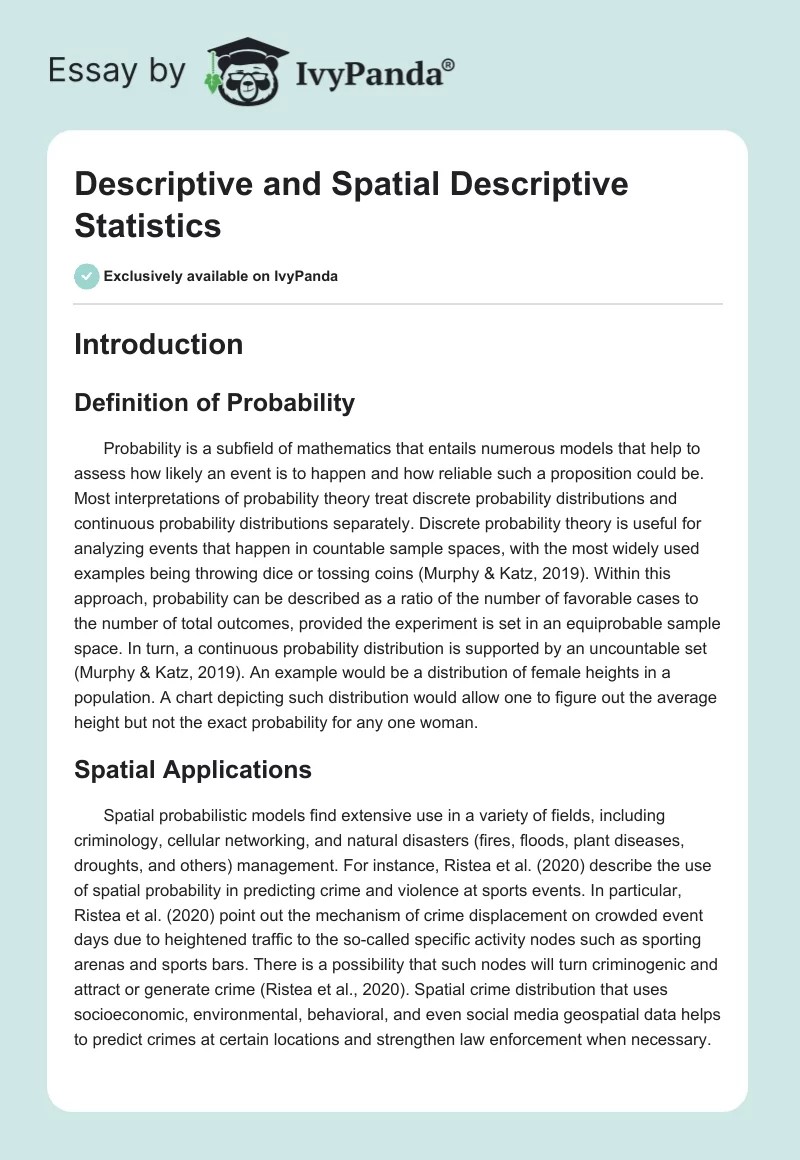Introduction
Definition of Probability
Probability is a subfield of mathematics that entails numerous models that help to assess how likely an event is to happen and how reliable such a proposition could be. Most interpretations of probability theory treat discrete probability distributions and continuous probability distributions separately. Discrete probability theory is useful for analyzing events that happen in countable sample spaces, with the most widely used examples being throwing dice or tossing coins (Murphy & Katz, 2019). Within this approach, probability can be described as a ratio of the number of favorable cases to the number of total outcomes, provided the experiment is set in an equiprobable sample space. In turn, a continuous probability distribution is supported by an uncountable set (Murphy & Katz, 2019). An example would be a distribution of female heights in a population. A chart depicting such distribution would allow one to figure out the average height but not the exact probability for any one woman.
Spatial Applications
Spatial probabilistic models find extensive use in a variety of fields, including criminology, cellular networking, and natural disasters (fires, floods, plant diseases, droughts, and others) management. For instance, Ristea et al. (2020) describe the use of spatial probability in predicting crime and violence at sports events. In particular, Ristea et al. (2020) point out the mechanism of crime displacement on crowded event days due to heightened traffic to the so-called specific activity nodes such as sporting arenas and sports bars. There is a possibility that such nodes will turn criminogenic and attract or generate crime (Ristea et al., 2020). Spatial crime distribution that uses socioeconomic, environmental, behavioral, and even social media geospatial data helps to predict crimes at certain locations and strengthen law enforcement when necessary.
Elmahdy et al. (2016) show how a weighted probability model can empower geographic information systems to predict landslides that are a constant threat in several mountainous regions in Malaysia. Automated algorithms allow for the construction of improved geological maps that are based on remote sensing data. Such maps helped Elmahdy et al. (2016) calculate the elevation and slope range of areas that pose the most threat to the residents. Lastly, there are numerous studies such as the one by Phillipson and Erdbrink (2015) that demonstrate the capacity of spatial probability in improving the cost-efficiency of cellular networks for mobile operators by analyzing the spatial traffic.
Discussion
Advantages of Spatial Probability
An inarguable benefit of spatial probabilistic methods is their flexibility in identifying the explicit spatial relations of objects and events with regard to their distance, direction, and topology (Murphy & Katz, 2019). In addition, the spatial probability models help to uncover implicit spatial dependencies (Murphy & Katz, 2019). However, first and foremost, spatial probability mitigates risks and uncertainty that are indispensable from the decision-making process regardless of the industry. When applied to cellular network development, probability can help optimize investments by improving radio traffic planning. Ensuring safety is another advantage of spatial probability application. Natural hazard prediction not only saves lives and property but also allows decision-makers to make timely changes to infrastructure to boost its resilience. The same goes for crime analysis: understanding the geospatial dimension of crime allows for better staff distribution and a precise focus on the most criminogenic areas.
An Example of Spatial Probability in Meteorology
Spatial probability has been heavily in use in meteorology since the beginning of the 20th century, but it is in the last few decades that its methods have been dramatically improved. Some of the factors that accounted for the change are more precise and higher-resolution satellite and Earth-observational data and enhanced “Numerical Weather Prediction (NWP)” models (Murphy & Katz, 2019). It was also possible to reach new heights in boosting computational power to better represent the Earth’s atmosphere and gain meaningful, practical insights. Weather forecasts inform decisions made in sectors such as agriculture, energy, transportation, and water supply as well as by individuals who plan their daily errands and travel.
Probability concepts used in meteorology are associated with specific purposes. For instance, a frequentist model is fed data on the past occurrences of a weather event to make a prediction (Murphy & Katz, 2019). An example from the most recent research is a study by Zhuang et al. (2019) who investigated the spatial predictability of heavy rainfall events in East China with the help of spatial-based methods of probabilistic forecasting. The researchers were able to identify locations where the so-called strong-force and weak-force events were most likely to happen.
Conclusion
Probability is a powerful branch of mathematics that finds its application in many fields. I find it fascinating how mathematical modeling can empower us to make informed decisions about the future based on previous data. Personally, I am quite interested in geographic information systems for which geospatial probability is one of the primary methods. Aside from the technical side, I am compelled to learn about how geospatial probability makes people’s lives better by reducing crime, protecting them from natural disasters, or even simply offering them better mobile phone plans.
Reference
Elmahdy, S. I., Marghany, M. M., & Mohamed, M. M. (2016). Application of a weighted spatial probability model in GIS to analyse landslides in Penang Island, Malaysia. Geomatics, Natural Hazards and Risk, 7(1), 345-359.
Murphy, A., & Katz, R. W. (2019). Probability, statistics, and decision making in the atmospheric sciences. CRC Press.
Phillipson, F., & Erdbrink, R. (2015). Creating mobile traffic grids based on geospatial data and using cell assignment probabilities. In 2015 IEEE Symposium on Communications and Vehicular Technology in the Benelux (SCVT) (pp. 1-6). IEEE.
Ristea, A., Al Boni, M., Resch, B., Gerber, M. S., & Leitner, M. (2020). Spatial crime distribution and prediction for sporting events using social media. International Journal of Geographical Information Science, 1-32.
Zhuang, X., Zhu, H., Min, J., Zhang, L., Wu, N., Wu, Z., & Wang, S. (2019). Spatial predictability of heavy rainfall events in East China and the application of spatial-based methods of probabilistic forecasting. Atmosphere, 10(9), 490.


